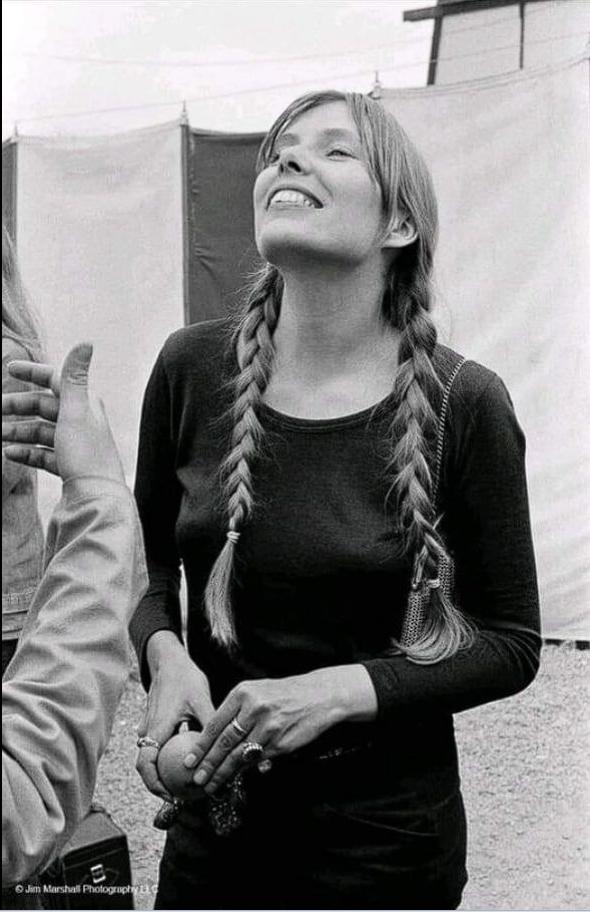“At the age of nineteen, Joni Mitchell, then a budding artist with a nascent musical inclination, enrolled in art school. For the preceding six months, she had been diligently teaching herself the baritone ukulele, a novice folk singer possessing just a handful of chords, enough to tentatively carry a traditional tune. In these early days, her musical world was rooted in the familiar melodies of folk tradition, with the notion of herself as a distinct and original musician still a distant and perhaps even unimaginable prospect. Her journey from this humble beginning to becoming one of the most influential songwriters of her generation is a testament to her persistent curiosity, her resilience in the face of early struggles, and the transformative power of unexpected encounters and artistic exploration.”
Early Explorations: Art School and Folk Beginnings:
- Art School as a Creative Crucible:
- Joni Mitchell’s initial pursuit of art school underscores her inherent artistic inclinations. Even before fully embracing music, she was drawn to creative expression, suggesting a fundamental artistic spirit that would later find its primary outlet in songwriting.
- This early immersion in the visual arts likely influenced her later lyrical imagery and her unique way of observing and portraying the world.
- Six Months on the Baritone Ukulele: A Novice’s Start:
- Her self-taught journey on the baritone ukulele, a mere six months in duration at this point, highlights her independent and autodidactic nature. It also reveals the relatively simple tools with which she began her musical exploration.
- This humble beginning underscores the organic and self-driven nature of her early musical development.
- Traditional Folk Songs: Rooted in Heritage:
- Her initial repertoire of traditional folk songs places her within a specific musical lineage, learning the foundations of melody and storytelling through established forms. This grounding in tradition provided a framework upon which she would later build her own unique style.
- This early phase was crucial in developing her ear and her understanding of song structure, even if she didn’t yet envision herself as an original composer.
- A Budding Singer, Not Yet a Musician in Her Own Right:
- The distinction made between being a “budding folk singer” and not yet thinking of herself as a “musician in her own right” is significant. It suggests a period of learning and imitation before the full realization of her own creative potential.
- This self-perception reflects the gradual process of artistic identity formation, moving from interpreter to original creator.

Navigating Early Challenges: Toronto and the Mariposa Festival:
- The Mariposa Folk Festival: Seeking Inspiration:
- Her travel to Toronto specifically to see the Mariposa Folk Festival demonstrates an active seeking of musical inspiration and a desire to immerse herself in the folk music scene. This suggests a growing internal pull towards music, even if she didn’t yet see a clear path for herself within it.
- This pilgrimage to a musical hub highlights her burgeoning interest and her desire to connect with the broader folk community.
- Buffy Sainte-Marie: An Inspiring Figure:
- Her specific interest in seeing Buffy Sainte-Marie perform suggests an early admiration for a strong, individualistic female artist within the folk genre. Sainte-Marie’s unique style and powerful presence likely resonated with Joni’s own nascent artistic sensibilities.
- This early influence points towards Joni’s inclination towards artists who defied convention and possessed a distinctive voice.
- An Outsider Looking In: Not Fully Picturing Herself:
- Despite being surrounded by music and inspiration at the festival, her inability to fully picture herself as part of that world reveals the practical and psychological barriers she faced. This highlights the gap between aspiration and perceived reality.
- This feeling of being an outsider looking in likely fueled her determination to find her own way into the music world.
- Financial Constraints: The Practicalities of Pursuing a Dream:
- The details of her financial struggles—not working regularly and lacking the $160 for the musicians’ union—ground her early aspirations in the harsh realities of trying to make a living as an artist.
- These practical obstacles underscore the challenges faced by many aspiring musicians and the sacrifices often required to pursue their passion.
- Working in Women’s Wear: Barely Getting By:
- Her taking jobs in women’s wear at a department store illustrates the necessity of finding practical means of survival while pursuing her artistic dreams. This period of barely getting by likely instilled a sense of resilience and determination.
- This mundane reality contrasts sharply with the artistic world she aspired to join, highlighting the often-unglamorous early stages of a creative career.

Finding a Foothold: The “Scab” Club and Early Performances:
- The Non-Union Club: An Opportunity for Exposure:
- Finding a non-union club in Toronto that would allow her to perform, despite the limitations, was a crucial step in gaining experience and exposure. This willingness to embrace unconventional avenues demonstrates her resourcefulness and determination.
- This “scab” club provided a vital platform for her to hone her skills and build confidence in a live performance setting.
- Gaining Experience and Confidence: Building a Foundation:
- Her months performing at this club were invaluable in developing her stage presence, refining her vocal delivery, and building the confidence necessary to pursue a musical career.
- This period of regular performance was essential in transforming her from a novice to a more seasoned performer.
- A Turning Point: Marriage and a Move to the US:
- Her marriage to Chuck Mitchell and the subsequent move to the United States marked a significant turning point, geographically and potentially in terms of her musical direction, as she entered a new environment and a musical partnership.
- This relocation broadened her horizons and exposed her to new musical influences.

The Duo Years: Facing Scarcity and Seeking Connection:
- Limited Success as a Duo: The Harsh Realities of the Circuit:
- Even as a duo, the scarcity of work and the struggle to break into established club circuits highlight the competitive and often exclusionary nature of the music industry. The low earnings of $15 a night underscore the financial challenges they faced.
- This period of limited success likely tested their resolve and forced them to seek out alternative ways to connect with the music community.
- Detroit and a Fifth-Floor Walkup: A Humble Abode:
- Their living situation in Detroit, a fifth-floor walkup with extra rooms, reflects their continued modest circumstances while also setting the stage for the communal environment that would foster her musical growth.
- This humble setting became an unexpected hub for a network of traveling musicians.
A Communal Space: The Influence of Fellow Musicians:
- A Hub for Traveling Folk Musicians:
- Their apartment became an “informal, communal space” for folk musicians on the road, creating a vital network of exchange and support. This environment exposed Joni to a wider range of musical styles and perspectives.
- This organic community provided a crucial learning environment and fostered a sense of belonging within the often-solitary life of a touring musician.
- Key Encounters: Andersen, Blue, Rush, Langhorne:
- The specific mention of influential figures like Eric Andersen, David Blue, Tom Rush, and Bruce Langhorne underscores the importance of these personal connections in Joni’s musical development. Each of these artists likely brought their own unique influences and insights.
- These interactions provided invaluable mentorship and exposure to different approaches to songwriting and performance.
- Eric Andersen’s Influence: Unlocking New Harmonic Depths:
- The specific mention of Eric Andersen teaching Joni new guitar tunings—Open G and Drop D Modal—marks a pivotal moment in her musical evolution. These tunings provided the key to unlocking “a new kind of harmonic depth.”
- This direct mentorship had a profound impact on her sound and her approach to the guitar.
- A Click, a Resonance: The Spark of Innovation:
- The description of something “clicking” and resonating with her “musical sensibility bubbling up inside” beautifully captures the moment of artistic breakthrough, where external influence aligns with an internal creative impulse.
- This signifies a crucial step in the development of her unique musical identity.

The Emergence of a Unique Voice: Transformation Through Harmony:
- Richer, More Expressive Chords: Expanding Musical Vocabulary:
- With these new, richer chords at her fingertips, Joni’s musical vocabulary expanded significantly, allowing for greater emotional depth and complexity in her compositions.
- This technical development was directly linked to the evolution of her songwriting.
- The Beginning of a Voice Uniquely Her Own:
- This period of exploration and discovery, fueled by new tunings and the influence of fellow musicians, marked “the beginning of a voice uniquely her own.” The harmonic innovations became a defining characteristic of her distinctive sound.
- This signifies the crucial transition from interpreting traditional songs to creating original and groundbreaking music.
Conclusion:
“Joni Mitchell’s early years were a journey of gradual self-discovery, marked by artistic curiosity, the challenges of pursuing a creative path amidst financial hardship, and the transformative influence of community and mentorship. From a novice folk singer with a few ukulele chords to an artist exploring the rich harmonic possibilities of open guitar tunings, her time spent navigating the early folk scene and connecting with fellow musicians in Toronto and Detroit was instrumental in shaping her unique musical voice. The encounter with Eric Andersen and the introduction to new tunings proved to be a pivotal moment, unlocking a harmonic depth that resonated with her inner musical sensibility and set her on the path to becoming the iconic and innovative songwriter the world would come to know.”
